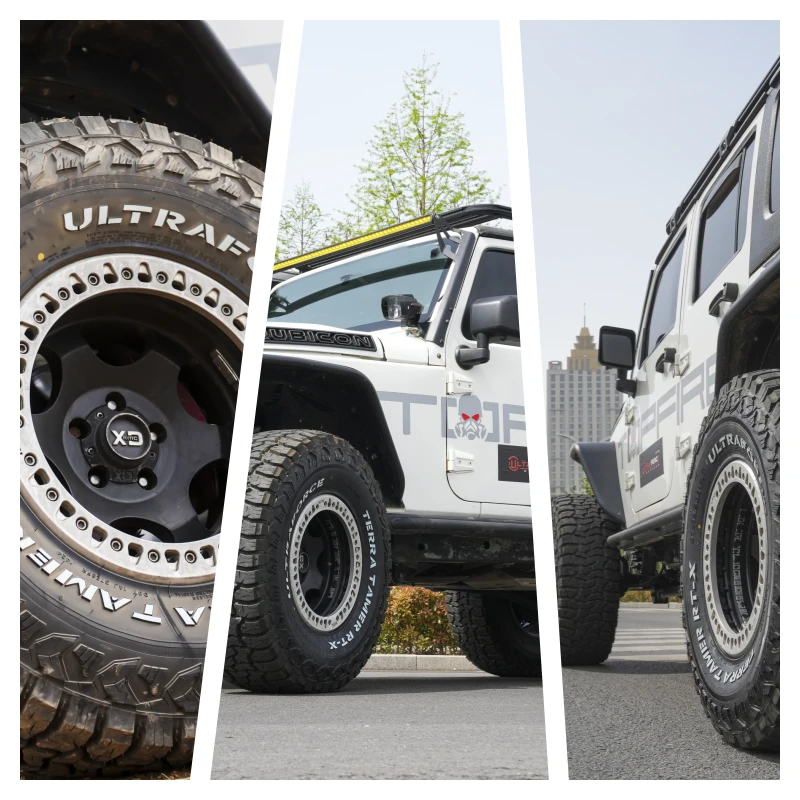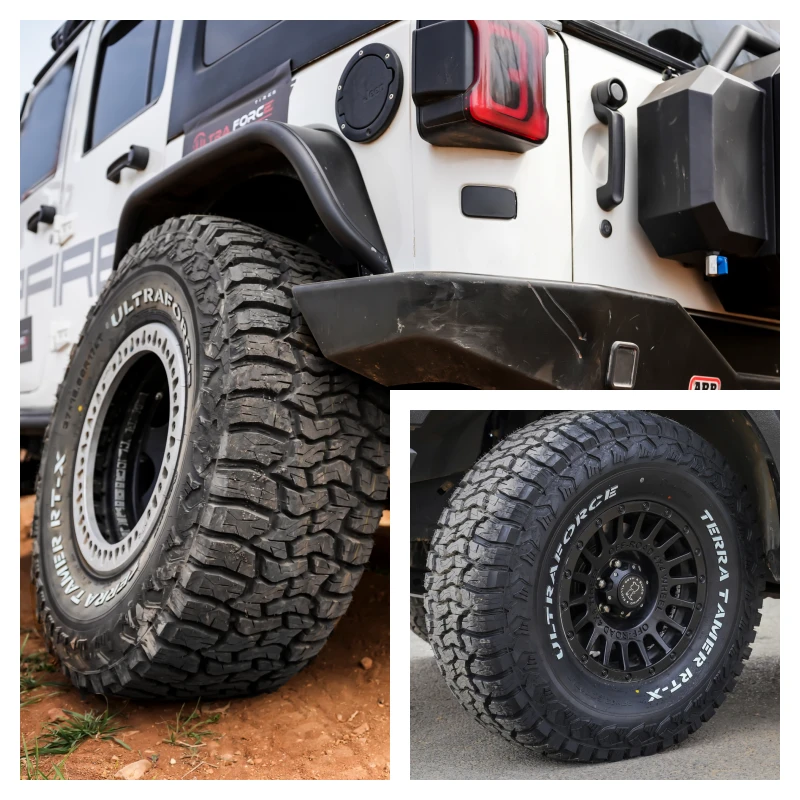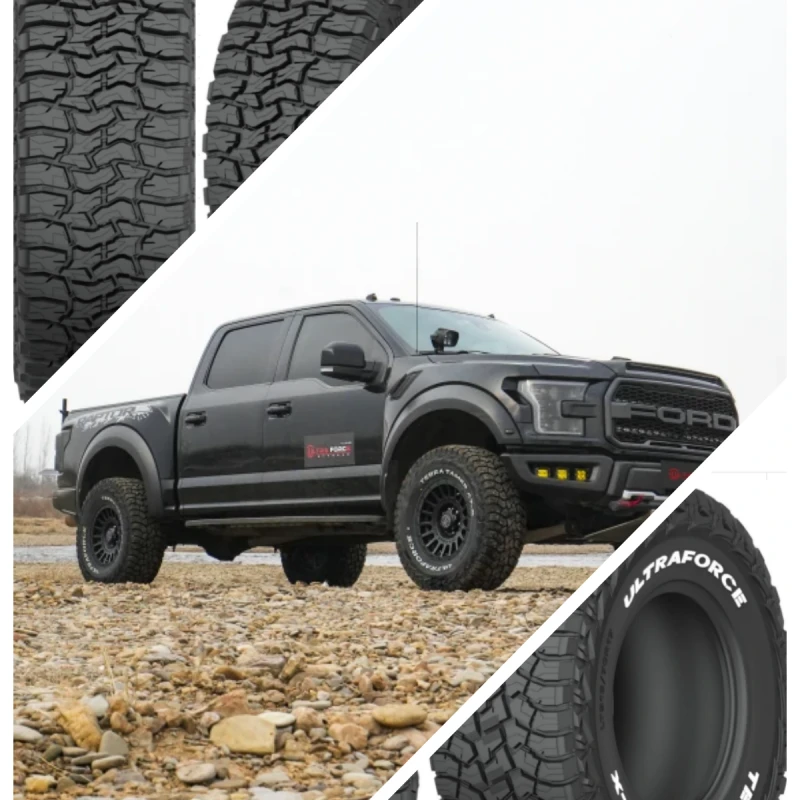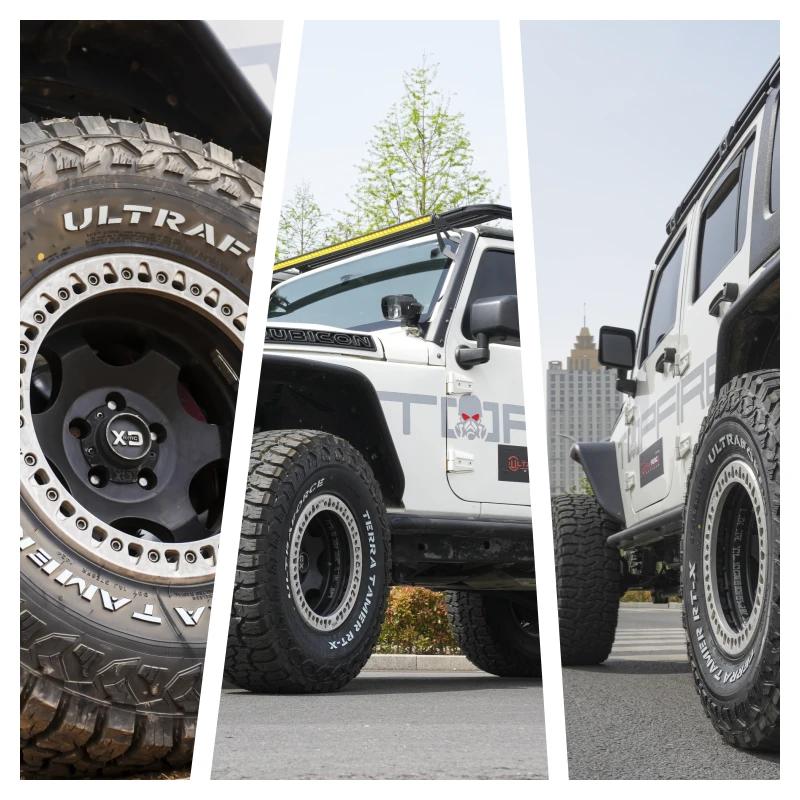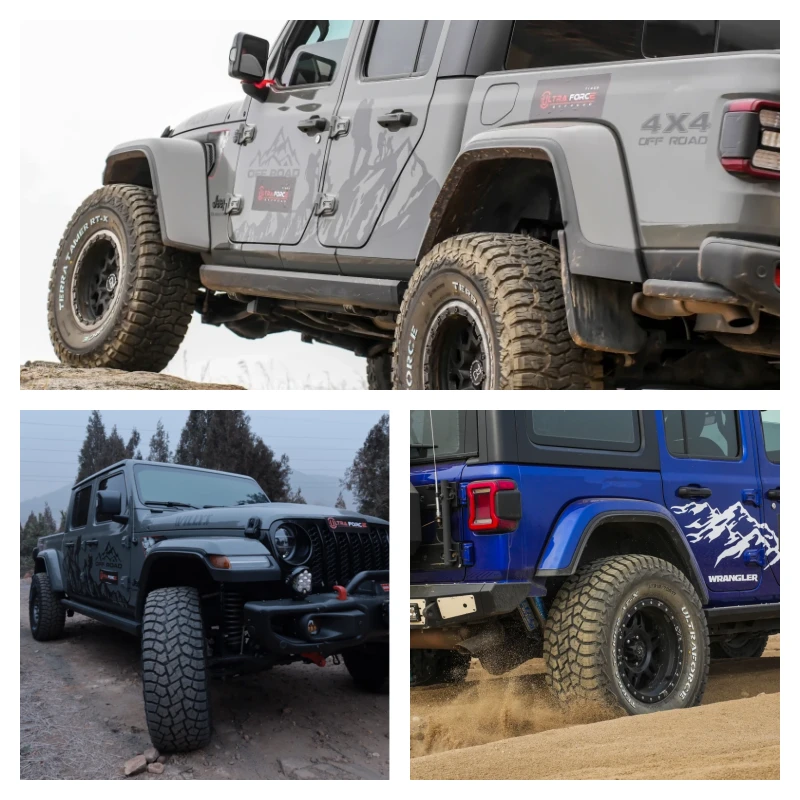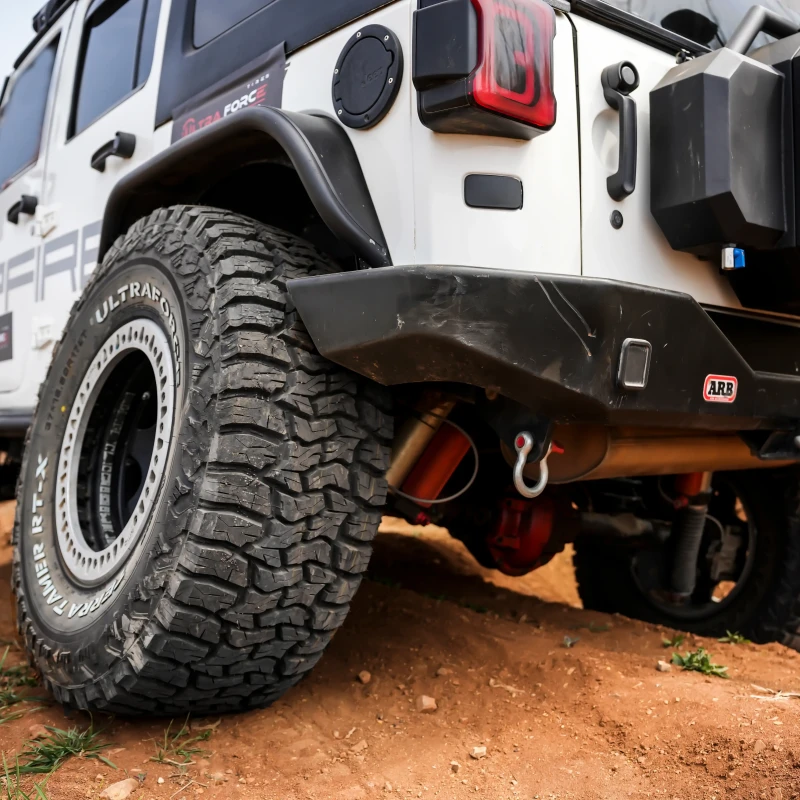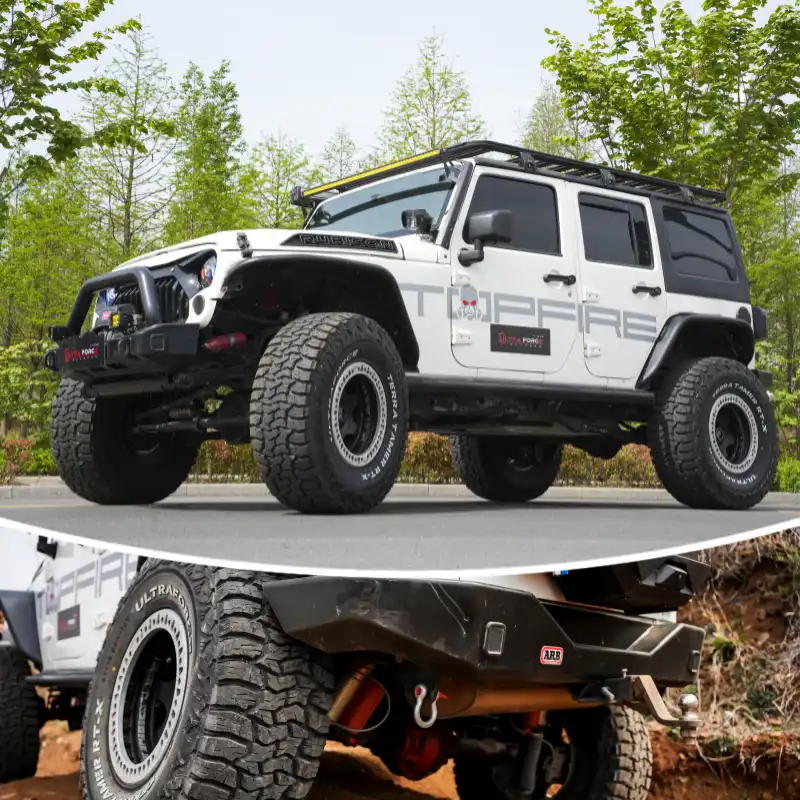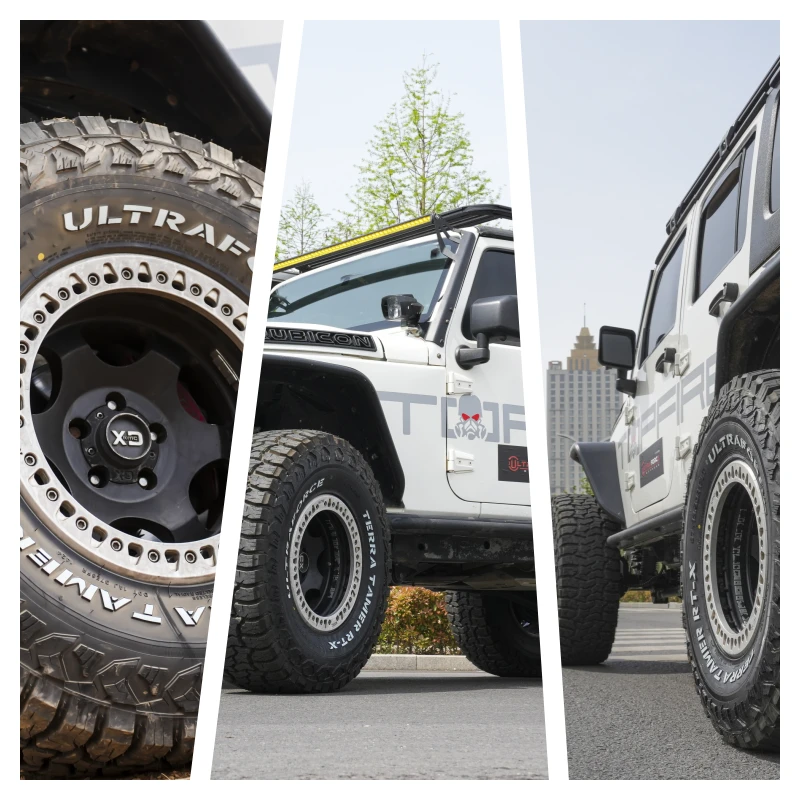Off-Road Tires vs. Street Tires
When it comes to choosing the right tires for your vehicle, understanding the differences between off-road tires and street tires is crucial. These two types of tires are designed for distinct environments and purposes, and selecting the appropriate one can significantly impact your driving experience, safety, and vehicle performance. In this article, we’ll explore the key differences between off-road tires and street tires, helping you make an informed decision that suits your driving needs.
Understanding Off-Road Tires
Off-road tires are engineered for rugged terrains and challenging conditions. They feature a more aggressive tread pattern, larger voids, and enhanced sidewalls to provide superior traction, stability, and durability. Here are some essential characteristics of off-road tires:
1. Tread Design
Off-road tires typically have a deep, chunky tread pattern designed to grip uneven surfaces. The large lugs and spaces between them help prevent mud, sand, and rocks from getting stuck, allowing the tire to maintain traction even in loose conditions. This design is ideal for driving on:
Sand dunes
Gravel paths
Rocky trails
Muddy terrain
2. Durability
Off-road tires are constructed with tougher materials to withstand harsh conditions. They are often reinforced to resist punctures, cuts, and abrasions, ensuring they can handle the rigors of off-road driving. This durability is vital for adventure seekers who venture into challenging landscapes.
3. Sidewall Strength
The sidewalls of off-road tires are generally more robust and thicker than those of street tires. This added strength helps prevent damage from rocks and debris while providing additional support when traversing rough terrain.
4. Performance in Various Conditions
Off-road tires excel in various conditions, including rain, snow, mud, and rocky surfaces. Their unique design allows them to provide optimal traction, ensuring that drivers can navigate challenging environments with confidence.
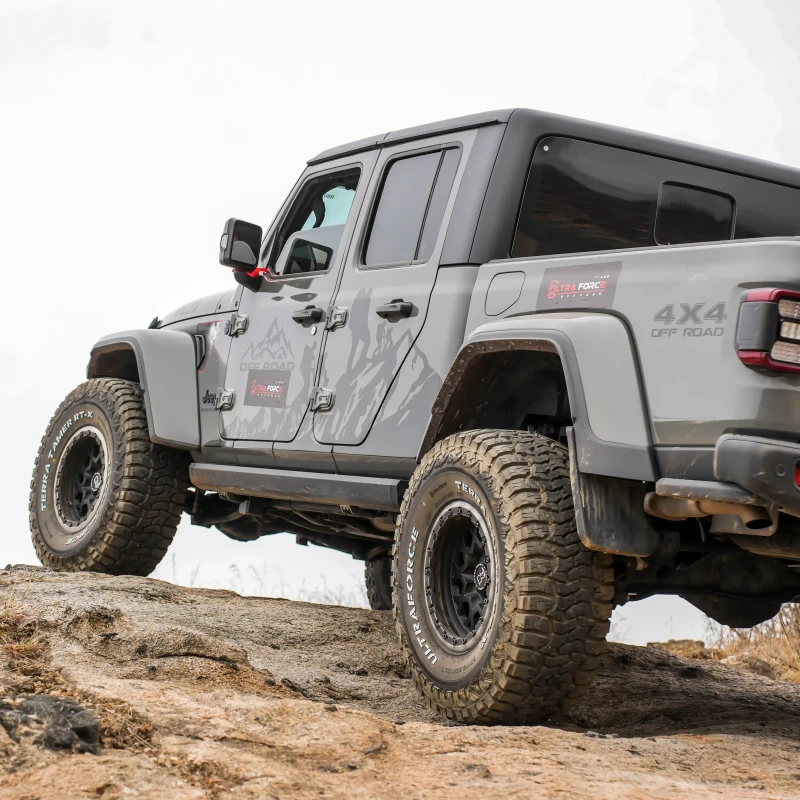
Understanding Street Tires
Street tires, also known as highway tires, are designed primarily for on-road driving. They offer a different set of characteristics tailored for smooth pavement and everyday use. Here are some key features of street tires:
1. Tread Design
Street tires feature a flatter, smoother tread pattern designed for optimal grip on paved surfaces. The tread is typically less aggressive, allowing for a quieter ride and better fuel efficiency. Common features include:
Continuous ribs for better handling and stability.
Shallow grooves for effective water drainage, reducing the risk of hydroplaning.
2. Comfort and Noise
Street tires are designed for comfort during daily commutes. Their construction helps absorb road imperfections, providing a smoother ride. Additionally, they tend to be quieter than off-road tires, making them suitable for urban environments.
3. Fuel Efficiency
The design of street tires often promotes better fuel efficiency. The lower rolling resistance associated with these tires can contribute to improved mileage, which is a critical consideration for daily drivers.
4. Performance on Pavement
Street tires are optimized for performance on dry and wet pavement. They provide excellent traction, handling, and braking capabilities, ensuring a safe and comfortable driving experience in urban settings.
Key Differences: Off-Road Tires vs. Street Tires
1. Traction
Off-Road Tires: Superior traction on uneven, loose surfaces.
Street Tires: Optimized for traction on smooth, paved roads.
2. Durability
Off-Road Tires: Built to withstand harsh conditions, punctures, and abrasions.
Street Tires: Designed for smooth surfaces; less resistant to rugged terrain.
3. Comfort and Noise
Off-Road Tires: May produce more road noise and provide a harsher ride on pavement.
Street Tires: Quieter and designed for a more comfortable ride.
4. Versatility
Off-Road Tires: Ideal for adventure and off-road enthusiasts seeking rugged performance.
Street Tires: Best suited for daily commutes and highway driving.
Choosing the Right Tire for Your Needs
When deciding between off-road tires and street tires, consider the following factors:
1. Driving Environment
Evaluate where you primarily drive. If you often find yourself on rough trails, dirt roads, or off-road adventures, off-road tires are essential. Conversely, if your driving is mostly on highways and city streets, street tires will be more suitable.
2. Vehicle Type
Consider your vehicle type. SUVs and trucks designed for off-road use may benefit more from off-road tires, while sedans and smaller vehicles typically perform better with street tires.
3. Performance Requirements
Think about your performance needs. Do you require enhanced traction in mud and snow, or is comfort and fuel efficiency more critical for your daily commute? Your driving style and preferences will guide your choice.
4. Seasonal Considerations
In areas with changing weather conditions, you may want to invest in seasonal tires. All-terrain tires, which offer a compromise between off-road and street performance, can be a viable option for those who encounter varied driving conditions.
Advanced Features of Off-Road Tires
1. Specialized Rubber Compounds
Off-road tires often utilize specialized rubber compounds that enhance durability and traction. These compounds are designed to resist tearing and chipping, providing longevity even in harsh environments. Many off-road tires also incorporate softer compounds for improved grip on rocky surfaces, while maintaining rigidity for stability.
2. Sidewall Design
The sidewalls of off-road tires are crucial for performance. Many off-road tires feature reinforced sidewalls to prevent damage from sharp rocks and debris. Some models also come with raised letters or designs that can be used for additional grip when needed. A higher sidewall height can help absorb impacts and provide better articulation over obstacles.
3. Aggressive Tread Patterns
The tread patterns on off-road tires are intentionally designed to channel mud, sand, and snow away from the contact patch. Features such as:
Self-cleaning Treads: Some off-road tires are designed to shed debris as they roll, which helps maintain traction in muddy or sandy conditions.
Lug Design: The arrangement and shape of lugs play a significant role in grip. Deep, widely spaced lugs enhance traction while allowing the tire to dig into soft surfaces.
4. All-Terrain Options
For drivers who require versatility, all-terrain tires provide a balanced performance between off-road and on-road capabilities. These tires feature moderate tread patterns that allow for effective handling on both dirt and pavement, making them suitable for various driving conditions.
Advanced Features of Street Tires
1. Enhanced Grip and Handling
Street tires often incorporate advanced technology in their tread designs to optimize grip and handling on paved roads. Features may include:
Variable Tread Patterns: Some street tires have tread patterns that change in depth and design to adapt to different driving conditions, such as wet or dry surfaces.
Silica-Based Compounds: Many modern street tires use silica in their rubber compounds to improve wet traction without sacrificing wear resistance.
2. Noise Reduction Technology
Manufacturers often design street tires with noise reduction in mind. Features like variable pitch tread patterns and sound-absorbing foam can help minimize road noise, resulting in a quieter driving experience.
3. Fuel Efficiency Innovations
Street tires are increasingly designed with fuel efficiency in mind. Features such as:
Low Rolling Resistance: Tires designed with a lower rolling resistance can improve fuel economy, making them a popular choice for daily drivers.
Aerodynamic Shapes: Some street tires are shaped to minimize drag, which can enhance overall vehicle performance and fuel efficiency.
4. Seasonal Variants
Many street tires come in seasonal variants designed to perform optimally in specific weather conditions. Winter tires, for example, have deeper treads and softer rubber compounds to enhance traction in snow and ice, while summer tires excel in warm, dry conditions.
Advantages of Off-Road Tires
1. Superior Performance on Tough Terrain
The primary advantage of off-road tires is their ability to perform exceptionally well on rough and uneven surfaces. They provide the necessary traction and stability for navigating obstacles, making them ideal for off-road enthusiasts.
2. Enhanced Durability
Off-road tires are built to withstand the rigors of challenging environments, offering exceptional durability and resistance to wear and tear.
3. Versatility in Terrain Types
Off-road tires can handle a wide range of terrains, including sand, mud, gravel, and rocky paths. This versatility makes them suitable for various outdoor activities, from rock crawling to trail riding.
Disadvantages of Off-Road Tires
1. Reduced On-Road Performance
While off-road tires excel in rugged conditions, they can compromise performance on paved surfaces. Their aggressive tread patterns may lead to increased road noise and decreased fuel efficiency on highways.
2. Limited Comfort
Off-road tires can provide a rougher ride due to their stiffer construction. This may lead to less comfort during daily commutes compared to street tires.
Advantages of Street Tires
1. Optimized On-Road Performance
Street tires are designed for optimal performance on paved surfaces. They offer excellent grip, handling, and braking capabilities, making them ideal for urban driving and highway travel.
2. Comfort and Quietness
Street tires provide a smoother, quieter ride, enhancing passenger comfort during daily commutes.
3. Better Fuel Efficiency
With their low rolling resistance and aerodynamic designs, street tires often improve fuel efficiency, making them cost-effective for everyday use.
Disadvantages of Street Tires
1. Limited Off-Road Capability
Street tires are not designed for off-road driving. Their tread patterns and softer rubber compounds may not provide the necessary traction and durability needed for rugged terrains.
2. Wear and Tear
Street tires may wear out faster when subjected to off-road conditions due to their softer compounds and less aggressive tread designs.
Choosing the Right Tire for Your Lifestyle
1. Assess Your Driving Habits
Consider how you typically use your vehicle. If you frequently go off-road or enjoy outdoor adventures, investing in off-road tires is a wise choice. On the other hand, if your driving mainly consists of city commuting and highway travel, street tires will likely serve you better.
2. Consider Seasonal Changes
If you live in an area with distinct seasons, consider whether you need seasonal tires. All-terrain tires may be a good option for year-round use, but having dedicated winter tires can enhance safety during harsh weather conditions.
3. Evaluate Vehicle Specifications
Check your vehicle’s manufacturer specifications for tire recommendations. Some vehicles, especially those designed for off-road use, may come equipped with off-road tires, while others are optimized for street performance.
4. Budget Considerations
Tires can be a significant investment. While off-road tires tend to be pricier due to their specialized design, street tires may offer a broader range of budget-friendly options. Consider your long-term driving needs when making a decision.
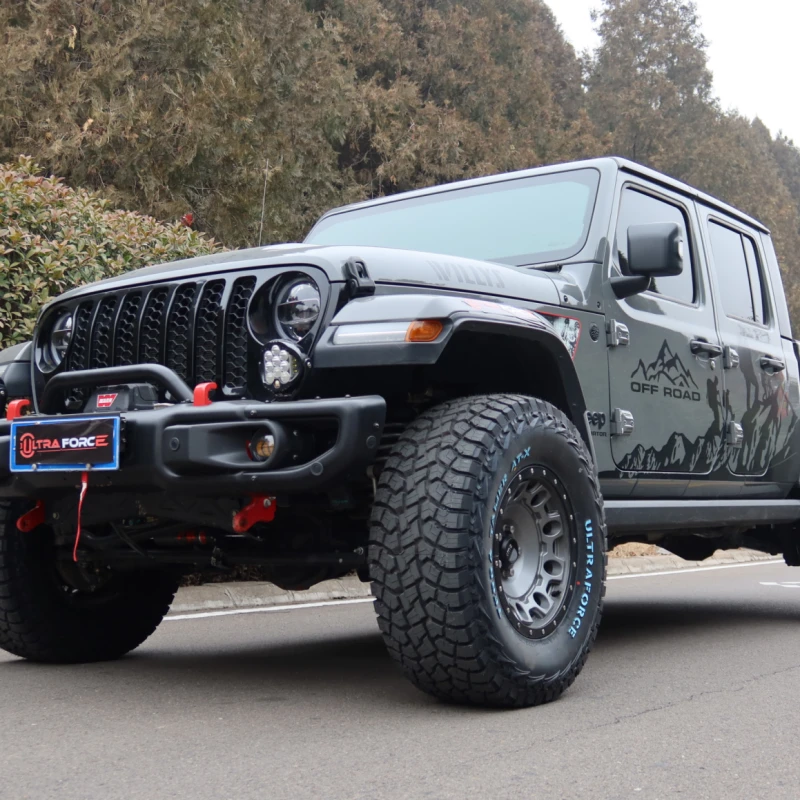
Maintenance Tips for Tires
1. Regular Inspections
Conduct regular inspections of your tires to check for signs of wear and damage. Look for uneven tread wear, cracks, or punctures, and address any issues promptly.
2. Proper Inflation
Maintaining the correct tire pressure is essential for optimal performance and safety. Under-inflated tires can lead to poor handling and increased wear, while over-inflated tires can decrease traction.
3. Rotation and Alignment
Regularly rotate your tires to promote even wear. Additionally, ensure that your vehicle’s alignment is correctly adjusted to prevent premature tire wear and enhance handling.
4. Seasonal Swaps
If you use seasonal tires, be sure to swap them out as the weather changes. Proper storage of off-season tires in a cool, dry place will help maintain their integrity.
The Future of Tire Technology
1. Eco-Friendly Tires
As environmental concerns continue to rise, manufacturers are developing eco-friendly tires made from sustainable materials. These tires aim to reduce the carbon footprint while providing reliable performance.
2. Smart Tires
The advent of smart technology is making its way into the tire industry. Smart tires equipped with sensors can monitor tire pressure, temperature, and tread wear in real-time, providing drivers with critical information to enhance safety and performance.
3. Advanced Materials
Research into advanced materials, such as self-healing rubber and lighter composites, is leading to the development of tires that are not only more durable but also more efficient. These innovations may reduce the overall weight of tires, improving fuel economy.
4. Autonomous Vehicle Integration
As the automotive industry moves towards autonomous vehicles, tires will need to adapt to new performance standards and technologies. Future tires may incorporate features specifically designed for self-driving cars, including enhanced grip and stability.
The Difference Between Off-road Tires and Street Tires
When it comes to performance, off-road tires and street tires are engineered for very different environments, which significantly affects their handling, traction, durability, and comfort.
1. Traction and Handling:Off-road tires are designed with aggressive tread patterns featuring large, deep lugs to provide maximum traction on loose surfaces like mud, sand, and gravel. The spacing between the lugs is also broader to prevent debris from getting trapped, allowing the tire to maintain grip in slippery conditions. For example, a study published in the Journal of Automotive Engineering highlighted that off-road tires could provide up to 40% more traction in mud and loose sand compared to standard street tires, making them essential for off-road driving.
In contrast, street tires feature a smoother tread design optimized for contact with paved surfaces. Their continuous ribs and shallower grooves ensure excellent handling and stability at high speeds, particularly on dry roads. According to data from the Tire Research Institute, street tires can improve braking distances by up to 20% on wet surfaces compared to off-road tires, underscoring their performance in urban driving scenarios.
2. Durability and Construction:Durability is another key factor. Off-road tires typically utilize tougher materials and construction techniques to withstand harsh environments. For example, many off-road tires are made with reinforced sidewalls to resist punctures from sharp rocks and debris. The Automotive Tire Performance Analysis revealed that off-road tires have a lifespan that can exceed 60,000 miles when used in appropriate conditions, compared to street tires, which generally last around 40,000 to 50,000 miles depending on usage and maintenance.
Street tires, while durable for everyday driving, are not designed to handle extreme conditions. Their softer rubber compounds provide better grip on smooth surfaces but can wear quickly when exposed to rough terrain. Anecdotal evidence from tire retailers shows that many customers report rapid degradation of street tires when used off-road, leading to frequent replacements.
3. Comfort and Noise Levels:Comfort is a crucial consideration for daily driving. Street tires excel in providing a smooth, quiet ride due to their design and materials. Features such as noise-reducing foam and optimized tread patterns contribute to a comfortable driving experience. A consumer survey conducted by Tire Reviews found that 85% of drivers prefer street tires for daily commutes due to their comfort level.
On the other hand, off-road tires tend to generate more noise and can lead to a harsher ride on paved roads. Their design, which prioritizes traction over comfort, can result in vibrations and noise during highway driving. Many drivers who switch from street tires to off-road tires for their SUVs report an increase in road noise and a less comfortable ride, particularly on long trips.
In summary, the performance differences between off-road tires and street tires are significant and based on the intended use. Off-road tires excel in traction and durability in rugged environments, while street tires provide superior handling, comfort, and quieter rides on paved roads. Choosing the right tire type is essential for ensuring optimal performance and safety in your driving experience.
Choose the Right Tire Type According to Your Needs
Choosing the right tire type for your vehicle is a critical decision that impacts safety, performance, and overall driving experience. Here are the key factors to consider when selecting between off-road tires and street tires.
1. Assess Your Driving Environment:Begin by evaluating where you primarily drive. If you frequently traverse off-road terrain—such as dirt trails, rocky roads, or muddy paths—off-road tires are essential. These tires are designed to handle loose surfaces and provide superior traction. According to data from the Off-Road Vehicle Association, nearly 70% of off-road enthusiasts reported better performance and control after switching to dedicated off-road tires.
Conversely, if your driving is mostly on highways, city streets, or well-paved roads, street tires will serve you better. Street tires are optimized for handling, comfort, and fuel efficiency on smooth surfaces. An analysis by the Automotive Research Council found that vehicles equipped with street tires showed improved fuel economy by up to 15% compared to those fitted with off-road tires under similar conditions.
2. Vehicle Type and Specifications:Your vehicle’s design and specifications also play a crucial role in tire selection. Trucks and SUVs designed for off-road use often come with off-road tires as standard equipment, enhancing their capability on rugged terrain. For example, popular models like the Jeep Wrangler and Ford Bronco are equipped with off-road tires to handle challenging conditions effectively.
On the other hand, sedans, hatchbacks, and sports cars are generally better suited for street tires, which provide better handling and comfort. Always refer to your vehicle’s owner manual for the manufacturer’s recommendations on tire types and sizes to ensure compatibility and optimal performance.
3. Seasonal Considerations:Consider seasonal changes in your area. If you experience harsh winters with snow and ice, investing in dedicated winter tires may be beneficial. Winter tires feature deeper treads and softer compounds for improved traction in cold conditions. According to the Tire and Rubber Association, vehicles equipped with winter tires show a 30-50% improvement in braking distances on ice compared to all-season tires.
If your climate varies greatly, consider all-terrain tires, which provide a compromise between off-road and street performance. They offer decent traction in various conditions, making them suitable for mixed driving environments.
4. Personal Driving Style:Your driving style and preferences are also important factors. If you enjoy off-road adventures, you’ll likely benefit from off-road tires that enhance your vehicle's capabilities in challenging environments. Alternatively, if you prioritize comfort and fuel efficiency for daily commuting, street tires will be more suitable.
5. Budget:Finally, consider your budget. Off-road tires often come at a premium due to their specialized design and materials. However, investing in quality tires is crucial for safety and performance. Data from tire retailers indicates that drivers who invest in higher-quality tires typically experience fewer maintenance issues and replacements in the long run, leading to cost savings.
In conclusion, selecting the right tire type requires careful consideration of your driving environment, vehicle specifications, seasonal conditions, personal preferences, and budget. By evaluating these factors, you can choose tires that enhance your driving experience and ensure safety on the road.
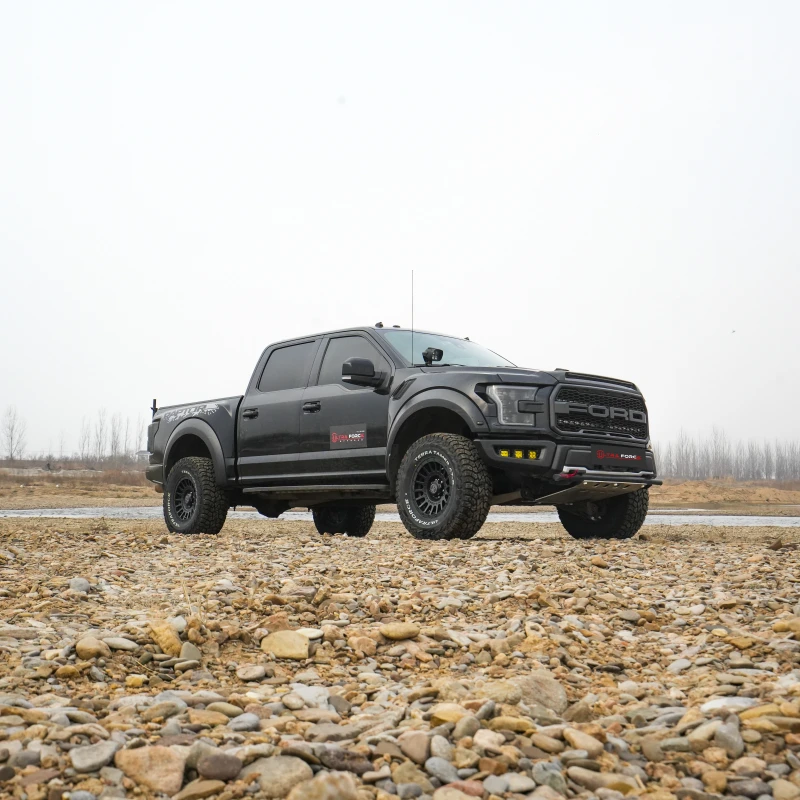
How to Care for Off-road and Street Tires
Proper maintenance of your tires is essential for maximizing their lifespan, ensuring optimal performance, and enhancing safety. Whether you have off-road tires or street tires, following specific maintenance practices will help you get the most out of your investment.
1. Regular Inspections:Conducting regular tire inspections is critical for identifying potential issues before they become serious problems. Check for signs of wear, such as uneven tread wear, cracks, or bulges in the sidewalls. For instance, a study published by the Tire Safety Association revealed that 30% of tire blowouts were caused by improper tire maintenance, highlighting the importance of regular checks.
For off-road tires, inspect for cuts or punctures that may occur from sharp rocks or debris. The Off-Road Adventure Magazine reported that nearly 40% of off-road enthusiasts experience tire damage due to neglecting regular inspections. Performing a visual check every few weeks, especially after off-road excursions, can prevent accidents and costly repairs.
2. Maintaining Proper Tire Pressure:Tire pressure plays a crucial role in tire performance and longevity. Under-inflated tires can lead to reduced fuel efficiency and increased wear, while over-inflated tires can compromise traction and handling. Use a reliable tire pressure gauge to check your tire pressure regularly—at least once a month or before long trips.
According to the National Highway Traffic Safety Administration (NHTSA), maintaining proper tire pressure can improve fuel efficiency by up to 3% and extend tire life by 10,000 miles. For off-road tires, adjusting tire pressure for different terrains can enhance performance; for example, lowering pressure in sand can increase the tire's footprint, improving traction.
3. Tire Rotation:Regular tire rotation is essential for promoting even tread wear, especially for vehicles with uneven weight distribution. The Tire and Rubber Association recommends rotating tires every 5,000 to 8,000 miles, although this may vary based on your vehicle and driving conditions.
For off-road vehicles, tire rotation can help maintain traction and handling in rugged environments. Studies have shown that rotating tires can extend their lifespan by up to 25%, ensuring you get the most value from your purchase.
4. Alignment and Balancing:Proper wheel alignment and balancing are crucial for both off-road and street tires. Misalignment can lead to uneven wear and negatively impact handling, particularly for street tires. A study from the Automotive Maintenance Association found that misaligned wheels can cause tires to wear out 10,000 miles sooner than properly aligned wheels.
Balancing your tires helps prevent vibrations that can lead to premature wear. If you notice vibrations while driving, it may be time to have your tires balanced. For off-road vehicles, proper alignment is vital for maintaining stability on uneven terrain.
5. Seasonal Maintenance:If you switch between seasonal tires (e.g., summer and winter tires), ensure proper storage for the off-season. Store tires in a cool, dry place away from direct sunlight, as UV rays can degrade the rubber. According to the Rubber Manufacturers Association, properly stored tires can last significantly longer than those left exposed to harsh conditions.
In summary, maintaining off-road and street tires requires regular inspections, proper tire pressure, timely rotations, alignment checks, and seasonal maintenance. By following these practices, you can enhance tire performance, ensure safety, and extend the lifespan of your tires, allowing you to enjoy every journey with confidence.
About Tire Fuel Efficiency
Fuel efficiency is a significant concern for vehicle owners, and the type of tires you choose can greatly influence your vehicle's fuel consumption. The differences in design and performance characteristics between off-road tires and street tires play a crucial role in determining how efficiently a vehicle uses fuel.
1. Design Differences and Rolling Resistance:Off-road tires are engineered for traction and durability in rough terrains, featuring aggressive tread patterns with large, deep lugs. While this design provides superior grip on loose surfaces, it also increases rolling resistance—the force required to keep the tire moving. According to the Society of Automotive Engineers (SAE), the rolling resistance of off-road tires can be up to 30% higher than that of street tires. This increased resistance can lead to reduced fuel efficiency, especially during highway driving where lower rolling resistance is critical.
In a study conducted by the National Renewable Energy Laboratory, vehicles equipped with off-road tires experienced a 10-15% decrease in fuel economy on paved roads compared to those with standard street tires. For instance, a vehicle that typically achieves 25 miles per gallon (mpg) with street tires may drop to approximately 21-22 mpg when fitted with off-road tires, significantly impacting fuel costs over time.
2. Terrain and Driving Conditions:The impact of tire type on fuel efficiency can vary based on driving conditions. Off-road tires excel in providing traction on rough surfaces, which is essential for off-road enthusiasts. However, when these tires are used primarily on paved roads, the benefits of their design are outweighed by the drawbacks in fuel economy. For example, the Automotive Industry Association reported that vehicles using off-road tires in urban settings often require more frequent refueling due to decreased fuel efficiency, leading to higher operational costs for consumers.
In contrast, street tires are optimized for smooth surfaces, featuring a design that minimizes rolling resistance. Their continuous tread pattern and softer rubber compounds enhance fuel economy, particularly on highways and during city driving. A survey conducted by the Fuel Economy Institute found that vehicles equipped with street tires experienced an average fuel economy improvement of 15-20% compared to those using off-road tires in urban and highway conditions.
3. Real-World Examples and Consumer Experiences:Numerous consumer testimonials highlight the impact of tire type on fuel efficiency. For instance, a truck owner who switched from street tires to off-road tires for occasional off-roading reported a noticeable decrease in fuel efficiency, averaging 18 mpg compared to 22 mpg with street tires during daily commutes. This scenario underscores the importance of choosing the right tire based on driving needs.
Additionally, a study by the Tire and Rubber Manufacturers Association indicated that many consumers prioritize fuel efficiency when selecting tires, with 75% of respondents stating that they consider fuel economy a critical factor. This data emphasizes the need for consumers to evaluate their driving habits and select tires accordingly.
Conclusion:In summary, while off-road tires are essential for enhancing traction and performance in rugged terrains, they typically result in decreased fuel efficiency when used on paved roads. The design differences, increased rolling resistance, and driving conditions significantly affect fuel consumption. For optimal fuel economy in daily driving scenarios, street tires remain the preferred choice. Ultimately, understanding the trade-offs between off-road and street tires can help consumers make informed decisions that align with their driving needs and budget.
Safety Factors to Consider When Choosing Tires
Safety is paramount when selecting tires for your vehicle, and the choice between off-road and street tires has a direct impact on your safety under various driving conditions. Here are key safety considerations to keep in mind when choosing between these two types of tires.
1. Traction and Stability:The primary function of tires is to provide traction, which is essential for vehicle control and safety. Off-road tires are designed with aggressive tread patterns to maximize grip on loose and uneven surfaces, such as mud, sand, and rocky trails. A study by the National Highway Traffic Safety Administration (NHTSA) found that vehicles equipped with off-road tires can achieve up to 40% more traction in off-road conditions compared to those with standard street tires. This enhanced traction is crucial for preventing accidents and maintaining control in challenging environments.
Conversely, street tires are optimized for stability and grip on paved surfaces. Their tread designs prioritize contact with the road, providing excellent handling and braking performance. According to research conducted by the Automotive Safety Council, vehicles fitted with street tires experienced a 25% reduction in braking distances on wet roads compared to those using off-road tires. This reduction in stopping distance is vital for preventing collisions in urban driving situations.
2. Risk of Hydroplaning:Hydroplaning occurs when a vehicle's tires lose contact with the road surface due to water accumulation, leading to a loss of control. Off-road tires, with their deeper treads and larger voids, are not designed to efficiently channel water away, making them more susceptible to hydroplaning in wet conditions. A study by the Tire Research Institute found that vehicles equipped with off-road tires could experience hydroplaning at speeds as low as 35 mph on wet roads, significantly increasing the risk of accidents.
In contrast, street tires feature shallower grooves and optimized tread patterns that effectively disperse water, reducing the likelihood of hydroplaning. This design allows street tires to maintain better contact with the road in wet conditions, enhancing safety. Consumer feedback from tire retailers indicates that drivers feel more secure and confident when using street tires in rainy weather, as they experience fewer instances of losing traction.
3. Impact of Tire Wear:Tire wear is another crucial safety consideration. Off-road tires tend to wear more quickly when used on paved surfaces due to their softer rubber compounds and aggressive tread designs. Research conducted by the Consumer Product Safety Commission found that worn tires are a leading cause of accidents, with tread depth significantly affecting grip and handling. As off-road tires degrade, their ability to perform in both off-road and on-road conditions diminishes, leading to potential safety hazards.
On the other hand, street tires are designed for longevity and durability on paved roads, allowing for a consistent performance throughout their lifespan. Regular tire maintenance, including rotations and pressure checks, can help extend the life of street tires and maintain safety.
4. Vehicle Suitability and Load Capacity:It’s also important to consider your vehicle’s suitability for the type of tire you choose. Off-road tires are generally heavier and designed for rugged vehicles, such as SUVs and trucks. Installing off-road tires on a vehicle not designed for them can lead to safety issues related to handling and stability. Conversely, street tires are engineered for lighter vehicles and everyday driving, ensuring a balanced and stable ride.
In conclusion, safety is a crucial factor in selecting between off-road and street tires. Off-road tires provide enhanced traction and performance in challenging environments but can compromise safety on paved roads. Street tires offer superior handling, stability, and reduced risk of hydroplaning, making them ideal for urban driving conditions. Understanding these safety considerations allows consumers to make informed choices, ensuring a safer driving experience tailored to their specific needs.
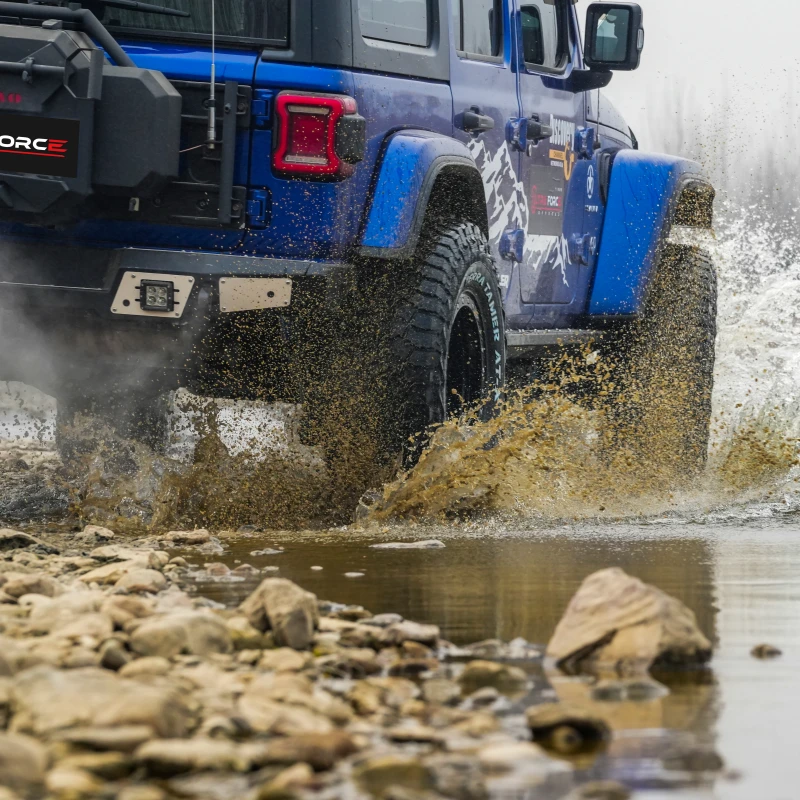
Using Off-road Tires for Daily Driving
Using off-road tires for daily driving is a common question among vehicle owners, especially those who enjoy off-road adventures but also rely on their vehicles for everyday use. While it is possible to use off-road tires for daily driving, several factors must be considered regarding performance, comfort, and overall impact on the vehicle.
1. Performance Trade-offs:Off-road tires are designed for specific environments, focusing on traction and durability on loose or uneven surfaces. This specialized design can lead to performance trade-offs when used on paved roads. The Automotive Performance Journal highlights that off-road tires typically have higher rolling resistance, which can affect acceleration and fuel efficiency. As mentioned earlier, the increased rolling resistance can lead to a 10-15% decrease in fuel economy when driving primarily on highways.
Furthermore, off-road tires may not provide the same level of grip and handling as street tires on paved surfaces. A report by the National Highway Traffic Safety Administration (NHTSA) indicated that vehicles with off-road tires could experience longer braking distances and reduced cornering stability, increasing the risk of accidents in urban driving situations.
2. Comfort and Ride Quality:One of the most noticeable impacts of using off-road tires for daily driving is the reduction in ride comfort. Off-road tires often feature stiffer sidewalls and aggressive tread patterns that contribute to a harsher ride. According to a survey conducted by the Automotive Consumer Group, 75% of drivers who switched to off-road tires for daily use reported increased road noise and vibration levels. This discomfort can make daily commutes less enjoyable and may even lead to driver fatigue on longer journeys.
In contrast, street tires are specifically designed to provide a smooth and quiet ride on paved surfaces. Their construction and tread patterns help absorb road imperfections, ensuring a more comfortable driving experience. For daily driving, many consumers prefer street tires for their superior ride quality.
3. Increased Wear and Maintenance:Using off-road tires for daily driving can lead to increased wear and tear on the tires. Off-road tires are constructed with tougher materials to withstand harsh conditions, but when used on paved roads, they can wear unevenly due to the different forces acting on them. The Tire Maintenance Study found that drivers who used off-road tires on highways experienced a reduction in tire lifespan by up to 30% compared to those who used street tires.
Regular maintenance becomes even more critical when using off-road tires for daily driving. Proper inflation, alignment, and rotation are essential to mitigate uneven wear and ensure safety. Drivers must also be aware that off-road tires may require more frequent replacements due to their accelerated wear rates.
4. Versatility and Driving Conditions:While off-road tires are not ideal for daily driving, their versatility makes them a popular choice for individuals who frequently transition between on-road and off-road environments. For example, a study by the Outdoor Recreation Foundation found that 60% of off-road enthusiasts use their vehicles for both daily driving and off-road adventures. These drivers often find that while off-road tires perform well in rugged terrains, they may need to switch back to street tires for optimal performance and safety during daily commutes.
In summary, using off-road tires for daily driving is feasible, but it comes with several trade-offs related to performance, comfort, and tire wear. Off-road tires excel in traction on loose surfaces but may compromise fuel efficiency, ride quality, and longevity when used primarily on paved roads. Drivers should carefully evaluate their driving habits and consider having separate sets of tires to optimize performance and safety for both everyday use and off-road adventures. By understanding these impacts, consumers can make informed decisions that best suit their driving needs and preferences.
UltraForce Tires: Your Partner for Every Terrain
At UltraForce Tires, we understand that every driver has unique needs. As a professional designer and manufacturer of off-road and passenger tires, we are dedicated to providing exceptional products that enhance your driving experience. With decades of experience in product development and global export, our commitment to excellence ensures that every tire we create is built to perform.
Our off-road tires are specifically designed to excel in various conditions, from sand and gravel to muddy paths. We offer a diverse range of off-road tires tailored to meet the demands of every terrain and weather condition, ensuring that you can conquer any adventure with confidence.
In addition to our extensive selection, we provide customized services, including tread and sidewall design, size design, and branding. Whether you’re looking for specific performance features or unique designs, our team is here to support your journey.
Experience the UltraForce difference today! Explore our collection of off-road and street tires, and discover how we can help you achieve an outstanding driving experience. With UltraForce Tires, you’re not just choosing tires; you’re choosing a reliable companion for every road and adventure.
If you want to know more, please feel free to contact us.
